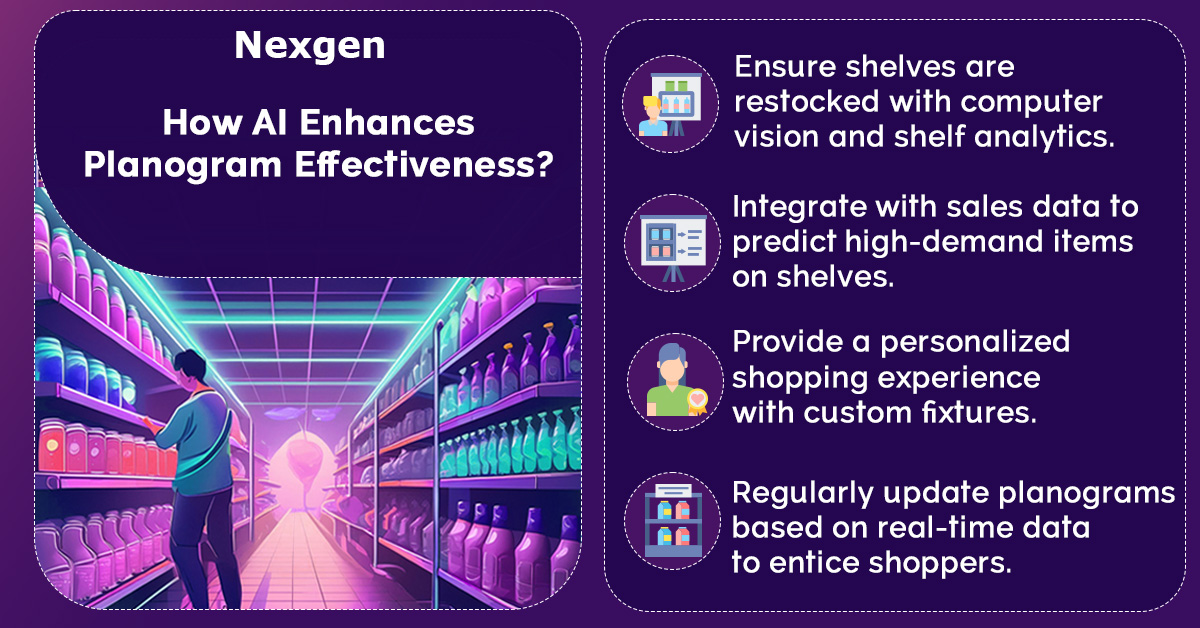In an age where technology continues to advance at high speed, brick-and-mortar retailers face an increasing need to innovate to stay competitive. One of the most promising sectors for this innovation is the integration of artificial intelligence (AI) into physical retail spaces. AI has the potential to revolutionize the shopping experience, enhance operational efficiency, and drive higher sales.
One key area where artificial intelligence can make a significant impact is the optimization of shelf space in stores. Planograms, the visual representations of a store's layout and product placement, play a crucial role in influencing shopping behavior and maximizing sales. With the help of artificial intelligence, retailers can automate and enhance this process, leading to significant benefits. Here is how employing AI with planograms can revolutionize your retail store.

How AI Enhances Planogram Effectiveness ?
- Data-driven insights: AI can analyze vast amounts of data to understand customer preferences, purchasing patterns, and seasonal trends. By leveraging this data, AI can create optimized shelf space planning planograms that cater to customer needs and preferences. For example, if data shows that certain products are frequently bought together, planograms can position these items adjacent to each other, facilitating easy access and boosting cross-merchandising opportunities.
- Dynamic planogram adjustments: Traditional planograms are static and can quickly become outdated as consumer preferences and market trends shift. AI enables dynamic adjustments to planograms based on real-time data. If a new trend emerges or if certain products start gaining popularity, AI can automatically update the planogram to reflect these changes, ensuring that the store layout always aligns with current consumer behavior.
Implementing AI-Driven Planograms
- Computer vision and shelf analytics: Computer vision technology allows AI to monitor shelves in real-time, ensuring that products are always correctly placed according to the planogram. This technology can identify when shelves need restocking or if products are misplaced, enabling prompt corrective action. This not only improves shelf management but also enhances the overall shopping experience by maintaining a well-organized and visually appealing store layout.
- Predictive analytics for inventory management: AI-driven planograms can integrate with predictive analytics to anticipate inventory needs. By analyzing historical sales data and considering factors such as seasonal trends and promotions, AI can predict which products will be in high demand and adjust the planogram accordingly. This ensures that high-demand items are prominently displayed and readily available, reducing stockouts and improving customer satisfaction.
- Personalized shopping experiences: AI can customize planograms based on customer demographics and shopping behaviors. For example, stores in different locations may have varying customer preferences. AI can analyze these regional differences and create tailored planograms that resonate with local customers. Additionally, for stores with loyalty programs, AI can utilize data from individual customer profiles to personalize the shopping experience further, potentially influencing store layout for frequent shoppers.
Benefits of AI-Driven Planograms
- Increased sales and revenue: Optimized product placement leads to increased visibility and accessibility of high-demand items, boosting sales. AI-driven planograms can also enhance cross-selling and up-selling opportunities by strategically placing related products together. This intelligent product arrangement encourages higher basket values and increases overall revenue.
- Enhanced customer experience: A well-organized store with easily accessible products creates a positive shopping experience. AI ensures that shelves are always stocked, and products are correctly placed, reducing the time customers spend searching for items.
- Operational efficiency: AI automates the time-consuming process of creating and updating planograms, freeing staff to focus on other critical tasks. Real-time shelf monitoring and dynamic adjustments reduce the need for manual interventions, leading to more efficient store operations and lower labor costs.
Overview of Nexgen POG
Nexgen POG is a robust and user-friendly cloud-based visual merchandising tool. It is designed for quick and efficient planogramming with minimal effort. Planogram in retail can be designed by easily dragging and dropping the products. The multi-device compatibility feature of POG allows you to obtain, share and edit planogram on any device, including your phone. It helps in designing store-specific planograms for increased product visibility and sales.
Get Your Free Trial Now!